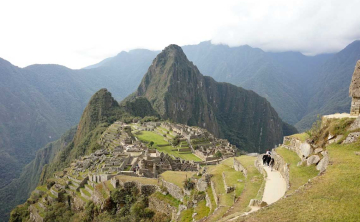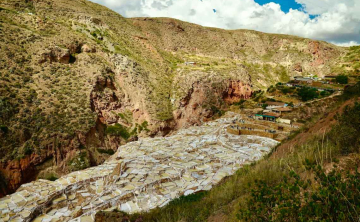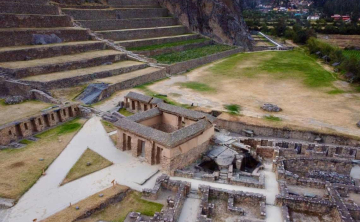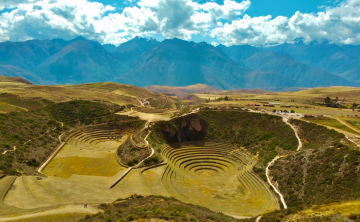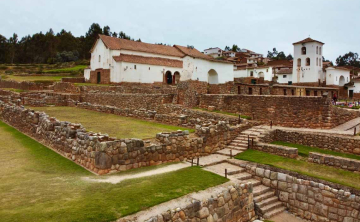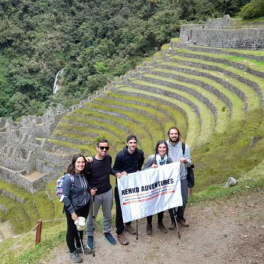Sacsayhuaman Archaeological Park

Sacsayhuaman, or as it's properly spelled in the Quechua language, Saqsaywaman, is an expansive archaeological park comprising smaller archaeological complexes and natural formations ingeniously utilized for the same purpose. However, this site is renowned for its awe-inspiring main megalithic construction spanning three impressive levels that astound even modern society, which deems itself capable of conquering all.
For our times, this is a must-visit destination during your sojourn in Cusco, not only for being a crowning achievement of Incan architecture but also because it stands as one of the world's most astonishing places.
This site epitomizes one of Pachacutec's grandest architectural visions ÔÇô the famous visionary ruler who thanked his father, the Sun, for the conquest of a world he utterly transformed, initiating the construction of a sanctuary befitting the grandeur he envisioned.
Location and access
Sacsayhuam├ín is located about 2 kilometers north of Cusco's historic center, on a plateau dominated by Cinca Hill (Senqa). The complex spans roughly 3,093 hectares, with natural and constructed terraces that overlook the city and distant mountains like Pacha Tusan and Ausangate. Visitors can reach the site via a short taxi ride or a scenic uphill walk from CuscoÔÇÖs Plaza de Armas, making it an accessible and essential stop for anyone exploring the region.
Travel tips
- Wear comfortable shoes for walking the uneven terraces and steep slopes.
- Bring sunscreen and water, as the altitude and sun exposure can be intense.
- Guided tours provide fascinating historical and cultural insights that enrich the experience.
- Consider visiting early in the morning or late afternoon to avoid crowds and enjoy optimal lighting for photography.
You might also want to check out: 20 fascinating facts about Inca Culture
The etymology of Sacsayhuamán
The literal translation of Sacsayhuaman as "Sated Falcons" (Sacsa: Sated / Human: Falcon) has been widely disseminated, substantiating this theory with a historical episode of war where multiple slain bodies were said to have been scattered, feeding the falcons that roamed around, sated by such bounty. This exact episode likely refers to the battle between the troops of Manco Inca and Pizarro's forces.
Our team has analyzed the context of the aforementioned translation, and while it is true that falcons exist in this place, they are not as common or abundant as to be a defining characteristic. Even in the context of a landscape littered with corpses, they would not be the ones to feed on these bodies but rather other birds that they could hunt, given that falcons do not scavenge carrion.
Kenko Adventures' team, offers a second opinion on the translation of this word, conducting an analysis of the Quechua language by Quechua speakers. We arrived at the following conclusion:
Sacsa: Or Saqsa, as it would be correctly written using the Quechua syllabary, indeed means "satisfied" or "sated," but only in one of its meanings. Another interpretation also translates to "full," "filled," or "stuffed" with something. For example: Saqsa Sara, this term is used to refer to a fully developed ear of corn where the kernels have completely filled the cob or core of the fruit. This example is widely used in the Andean agricultural context and can be easily corroborated.
Huamán: In addition to effectively meaning "Falcon," the word Huamán or Wamán is also a widespread surname in Cusco and Peru, generally interpreted as "Falcon," which is perhaps why this interpretation comes to mind first when hearing this word. However, few know that this word is also used to refer to rocks that sometimes, for some reason, hold sacred significance for the community in which they are found.
Therefore, when translating these two words, we could say that Sacsayhuaman or Saqsaywaman means "a place full or packed with rocks or stones of some sacred connotation", which would make much more sense.
The purpose behind Saqsaywaman's construction
Pachacutec's vision for the empire of the Sun led him to initiate the construction of a temple far more imposing than any before, primarily serving the cult of his father, the Sun, and the other deities they worshipped.
As part of his plan to redesign the city, he began building Saqsaywaman, later dubbed a fortress due to its imposing stone blocks and the clashes that ensued between the Incan and Spanish troops vying for control of Cusco. However, in our view, it was erected as a center of worship, an immortal sanctuary destined to endure forever.
Going on your own
- By Taxi: Hiring a taxi service allows you to easily visit the iconic Cristo Blanco statue and the breathtaking viewpoint where it resides. Keep in mind that when engaging these services, it's recommended to combine it with other visits like Tambomachay, Puca Pucara, Qenqo, and Sacsayhuaman itself.
- Via Public Transportation: Getting to Sacsayhuaman from Cusco by public transport is straightforward. Simply make your way to the sole stop on Puente Rosario street, near the Qorikancha (Temple of the Sun), and wait for a Cristo Blanco company bus. Their staff will gladly assist you in disembarking at the correct stop, a journey of around 30 minutes.
- On Foot: From Cusco's historic center, it's possible to walk to this awe-inspiring attraction. Just prepare accordingly and embark on the journey. Start at Plaza Nazarenas and ascend Pumacurco street until reaching Don Bosco, where you'll find the San Blas plazoleta. Continue uphill until reaching Sacsayhuaman's archaeological park entrance. Once there, you'll need to present identification, so carry your passport and tourist ticket if you have one, allowing you to also visit the park's other archaeological sites.
With a tour agency
Taking a Private Tour: With a private service including a dedicated vehicle and guide, you can not only visit Cristo Blanco but other highlights like Tambomachay, Qenqo, Puca Pucara, and Sacsayhuaman. If interested, click here - we also offer an intriguing night tour option.
You might also want to check out: What were the incas known for?
Design conception
Sacsayhuaman is the crowning centerpiece of a design masterminded by its chief architect, Pachacutec. Upon ascending to power, he redesigned the city to imbue it with unparalleled beauty. Lore recounts how he personally traced the streets' layout, shaping them into a puma ÔÇô the animal representing the present world (Kay Pacha) in Andean cosmovision.
Architectural descriptions
As mentioned, Sacsayhuaman archaeological park comprises approximately 33 archaeological groups, the standout being the principal ceremonial fortress ÔÇô its most alluring component. Constructed entirely around a mountain, its northern flank features the three iconic megalithic terraced bastions for which it's famed, towering between 4 and 5 meters high. The sedimentary limestone rocks used weigh an average of 90 to 125 tons each, with the largest exceeding 350 tons. Incredibly, they were transported from the Muyna Waqoto and Rumiqolca quarries, the farthest located nearly 20 kilometers away. Their joints are so precisely fitted that not even a needle could be inserted into the original structures.
Trapezoidal Gateways
The zigzagging terraces interconnect via staggered stairways punctuated by imposing trapezoidal gateways, also built from gargantuan stone blocks. These gateways have retained their original names: Tiu Punku, Acawana Punku, and Wiraqocha Punku.
Towering Bastions
Atop the three bastions once stood three towering fortified structures dominating Cusco ÔÇô approximately four modern stories tall with diameters of around 22 meters. They were dubbed Muyucmarca, Sayacmarca, and Pucarmarca.
The eastern, western, and southern sides were likewise walled, though less exquisitely than the northern front described above. It's worth noting that most walls remain buried, as per the pre-Incan Andean tradition of entombing and leaving any disused edifice to obscurity.
Three crosses now crown this mountain's summit, dominating Cusco's skyline and celebrated along with many others in May.
The Incan Throne
The mountain directly facing the three terraced bastions is also walled, its finely carved structures shoring up the slopes against erosion. Within this ensemble, the standout is the so-called Incan Throne ÔÇô an outcropping of living rock singularly carved into a throne-like shape. Its acoustic properties and vantage point are remarkable; perhaps the rulers overseeing construction once sat here, issuing booming commands.
Chincanas
Among Sacsayhuaman's most distinctive features are the "chincanas" ÔÇô natural formations in the area's characteristic limestone. The largest, seemingly unfathomably deep, has been sealed off due to reports of disappearances over time. The smaller one remains open to the public, connecting different zones in under a minute.
Toboganes (Slides)
The so-called "toboganes" are natural diorite rock formations resembling slides that have provided generations of fun for Cusco's residents, who continue polishing them to this day. Located on the rear side of the mountain directly facing the main bastions, they are also called "suchunas".
You might also want to check out: The best snacks while hiking in Peru
Legends and myths
Sacsayhuamán is not only an impressive archaeological complex; it is also a place full of stories and mysteries that have been passed down from generation to generation.
Stories of the Inca Throne and the Chincanas
It is said that the Inca Throne, a large block of rock carved in the shape of a seat, served as a vantage point for Inca rulers to observe and oversee the construction of the bastions. The chincanas, for their part, are natural tunnels and passageways that hold secrets of ancient rituals. Some local accounts claim that these galleries connected ceremonial areas and were used for initiation ceremonies.
Legends about the Bastions and Giant Stones
The enormous stones of Sacsayhuamán, some weighing more than 350 tons, have given rise to numerous legends. One says that the Incas had divine help to move them, while other stories recount that the spirits of the ancient builders still protect the site. These narratives reinforce the idea that Sacsayhuamán is more than architecture: it is a sacred and magical space.
Spirits and rituals
The Inca rituals at Sacsayhuamán were deeply connected to nature and Andean cosmology. It is believed that the ancients performed ceremonies for the Sun (Inti), the Moon (Mama Quilla), and other elements of their worldview, seeking balance and blessings for the city of Cusco and its people. Today, many visitors still feel the mystical energy that surrounds the site.
You might also want to check out: Inca calendar: Solar alignments at Machu Picchu
Sacsayhuamán and the andean worldview
Sacsayhuamán was much more than a fortress: it is a reflection of Andean thought, where architecture, religion, and nature are uniquely combined.
Relationship with the sun, the moon, and other deities
The complex was built following astronomical and spiritual principles. Each bastion and terrace had a ceremonial significance, aligned with the Sun, the Moon, and the stars, to mark important festivals such as Inti Raymi, the Festival of the Sun.
The Symbolism of the Puma in the planning of Cusco
The city of Cusco was designed in the shape of a puma, a sacred animal for the Incas, representing strength and protection. Sacsayhuamán occupies the head of this puma, uniting the city with the spiritual world and granting it a protective role against external threats.
Spiritual and ceremonial function
Beyond its military importance, Sacsayhuamán was a center of worship and ceremony. The Incas conceived it as an eternal place of connection with their gods and nature, where each stone and terrace fulfilled a symbolic purpose, reinforcing the power and vision of Pachacuti.
Sacsayhuam├ín: the ultimate guide to CuscoÔÇÖs iconic Inca fortress
Sacsayhuam├ín is far more than an archaeological site; it is a testament to the ingenuity, spirituality, and vision of the Inca civilization. From its colossal stone walls and intricate terraces to the mystical chincanas and the symbolic layout of Cusco, every element reflects a profound connection between architecture, nature, and Andean cosmology. Visiting Sacsayhuam├ín is not just a journey through historyÔÇöit is an opportunity to experience the cultural, spiritual, and architectural brilliance that continues to inspire awe today. Whether you are drawn to its engineering marvels, its legends, or its breathtaking panoramic views, Sacsayhuam├ín remains an essential destination for anyone seeking to understand the heart and soul of the Inca Empire.











